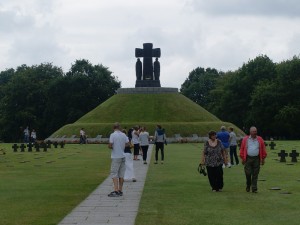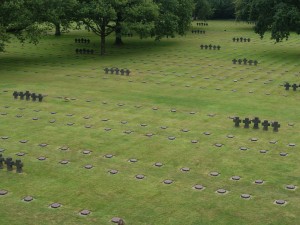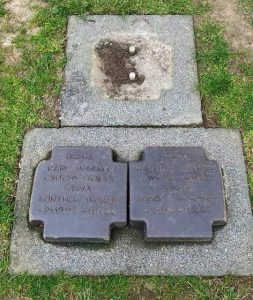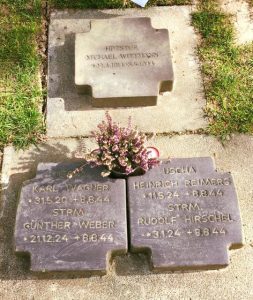Located just off the Route Nationale 13 (E46) some thirty kilometres west of Bayeux, the Military Cemetery (Soldatenfriedhof) at La Cambe is very easy to find and well signposted. Opened in 1961, La Cambe is the final resting place for over 21,000 German troops between the ages of sixteen and seventy-two who would lose their lives during the Normandy campaign in the summer of 1944.
How to get there
To get to the Soldatenfriedhof from Bayeux and the east, join the RN 13 heading west. Exit at the junction “La Cambe”, where you will join the road D 113 turning left. Head south away from the town – passing back over the RN 13 – and take the second exit at the first roundabout. Carry on straight up the westbound road running parallel to the RN, and turn into the entrance marked “Soldatenfriedhof”.
From Brittany and the west, join the RN 13 heading towards Bayeux. Exit at the junction “La Cambe”, and follow the instructions above. Due to the road layout, you will actually see and pass the cemetery on your right before turning back on yourself at the junction – it’s easy to be be confused into thinking that you’ve overshot the exit, but just following the signs will get you there.
[ready_google_map id=’1′]
Details
Deliberately understated with the headstones in dark grey – as opposed to the distinctive manicured bright white stone found in Allied cemeteries, the Soldatenfriedhof at La Cambe is quiet place for contemplation, and illustrates the extent of the losses suffered by the German forces. The centrepiece of the cemetery is the large mound or Tumulus (in German, Hügelgräber) which contains the bodies of 296 soldiers, of which 207 unknown or unidentified. Atop the Hügelgräber is a large basalt lava cross flanked by two figures representing a mother and father.
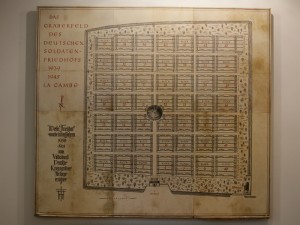 |
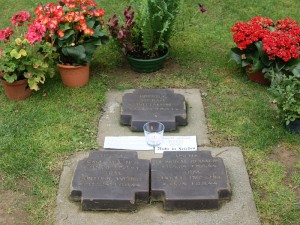 |
Also on the site is an information centre run by the German War Graves Commission (Volksbund Deutsche Kriegsgräberfürsorge e.V., or VDK), and a peace garden (Friedensgarten) containing 1,200 maple trees. The VDK does not receive any funding, and the cemetery is maintained by volunteers. Initially a temporary American cemetery, La Cambe was inaugurated on 21st September 1961, with the peace garden (Friedensgarten) opened twenty-five years later on 21st September 1996.
The graves of Michael Wittmann and his crew
Michael Wittmann and his crew are buried in third row of block 47 of the Soldatenfriedhof, which is located three blocks up on the right as you come through the main entrance. Originally the cemetery consisted of forty-two blocks divided into six columns, but as more bodies were discovered – including those of Tiger 007 – a further column would be added on the right.
In addition to Michael Wittmann, the grave of another Knight’s Cross winner from the 101st SS Heavy Panzer Battalion can also be located at the La Cambe cemetery. Located in the eighth row of block 30 in grave number 303 is SS-Untersturmführer Alfred Günther, Wittmann’s StuG gunner in 1941 and later commander of the 1st Platoon of Hanno Raasch’s 3. Kompanie. Günther was killed on 15th June 1944 when his Tiger was hit by enemy aircraft.
Stolen Gravestone
In the summer of 2015, news had broken of a shocking incident at La Cambe. On or around the night of 17th July, the headstone belonging to Michael Wittmann was stolen. No culprit was found and no reason given for this pointless and despicable act, and theories as to the motives of the theft varied from simple vandalism through to neo-Nazis wanting something for their mantelpiece.
Given that Wittmann’s grave was clearly targeted suggests that the vandalism was more than likely the work of trophy hunters. No other graves in the cemetery were affected, and the two stones for his four crewmen were left untouched.
The stolen gravestone was initially replaced by a simple marker, before a new replacement was laid down in October.
Address
La Cambe German war cemetery, Route Nationale, 14230 La Cambe, France
49.341944 N, 1.026389 W

